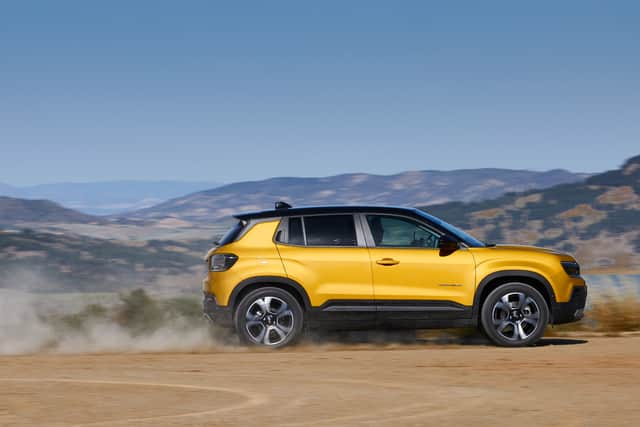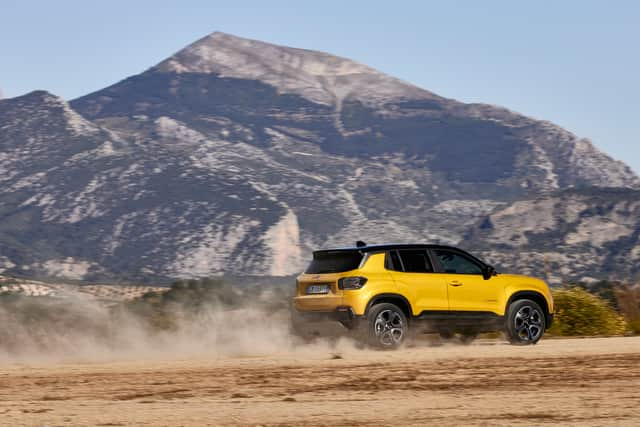2023 Jeep Avenger review: price, specs and performance of 4x4 specialist's first electric model


The Jeep Avenger is a big deal for the American 4x4 brand. It’s the firm’s first all-electric model and is the first of four planned Jeep EVs due by 2025. By the end of 2030, the whole Jeep line-up in Europe will be purely electric.
The Avenger is also a wholly European model from this most American of brands. It was designed in Europe for European roads and tastes and is built in Italy - Jeep’s home from home this side of the Atlantic.
Advertisement
Hide AdAdvertisement
Hide AdUnder the surface it uses the same updated eCMP2 platform as last year’s DS3 E-Tense, which means it gets Stellantis’s new bigger battery and more powerful motor, but 60% of the Avenger’s parts are unique to it. That’s obviously partly to give it its own external style but also to give it a different set of abilities to the DS.
Visually, the Avenger does a good job of bringing the posture and attitude of a Jeep into a compact SUV footprint. Like the bigger Wrangler there’s a Tonka toy aesthetic to its boxy body, with short overhangs and thick black cladding. That cladding is there to protect the paint from damage from low-speed scrapes and the slim lights are recessed into the bodywork for the same reason. Jeep reckons this could save owners up to £1,000 in minor repairs over the car’s life.
There’s a range of vibrant colours to choose from, including the pictured Sun Yellow and Lake Blue but buyers can customise it with everything from X-camo-patterned bonnet panels and grille stickers to roof and bonnet stripes, colour mirror caps and blue highlights on the machine-cut 18-inch alloys.
Those touches aside, Jeep says nothing on the car is there for purely aesthetic reasons - all part of its ambition to still represent the brand’s roots. So those short overhangs mean it has the best approach and departure angles of any car in its class. It also has class-leading ground clearance (as good as a Grand Cherokee's on-road setting) and three of the six drive modes are focused on difficult terrain or conditions.
Advertisement
Hide AdAdvertisement
Hide AdBut let’s not get carried away with ideas of some Rubicon-crossing mini Wrangler. Saying this is the most off-roady car in its class is a little like calling someone the most honest politician at Westminster or least greedy banker on Wall Street.
Under its admittedly rugged looking skin, the Avenger is a purely front-wheel-drive affair with a couple of smarter-than-average traction control modes for mud, snow and sand, plus off-road-intentioned hill descent control. So you’ll manage fine in a muddy field or gravelly forestry route but don’t go setting your electrified sights on the deep wilderness. Truthfully this, like every B-SUV, is a car designed for the city, where light and responsive steering and decent manoeuvrability work well.


It copes well on the open road as well though. Its 154bhp motor doesn’t offer exhilarating pace but it feels capable enough. There’s a slightly dulled throttle response and some limiting of power/torque in “normal” mode that means it doesn’t have the sharp response of some EVs. You can address this and unlock all the power either by burying your foot in the carpet or by selecting sport mode.This will shift the Avenger along slightly quicker but it’s still not a performance machine.
Sport mode also adds some more resistance to the steering for a “more dynamic” drive but the added weight feels artificial and the steering remains accurate but lifeless. You’re better off sticking with normal mode that’s more in keeping with its overall calm and smooth driving experience.
Advertisement
Hide AdAdvertisement
Hide AdUnlike a lot of petrol-powered alternatives, the Avenger rides really well. It coped smoothly with the admittedly decent roads of southern Spain but also shrugged off the worst of a potentially jarring rocky trail designed to show off the abilities of the sand driving mode. Given how pliant the suspension its, body control is equally impressive, with less lean than you’d expect from such a soft-riding machine. In tandem with that, there isn’t much in the way of noise intrusion either and road noise only becomes obvious at motorway speeds.
Powering the single 154bhp motor is a 54kWh battery (51kWh usable). Official testing pegs the Avenger’s consumption at an impressive 4 miles/kWh and range at 248 miles - both of which seem perfectly feasible on the basis of our test drives. Zero to 62mph will take 9.3 seconds and top speed is limited to 93mph. More importantly, a 20-80% charge will take just 24 mintutes thanks to standard 100kW DC charging.


The Avenger's overall interior layout is nice and straightforward, with a simple and welcome row of physical switches for the climate controls, the standard Stellantis drive mode and parking brake switches and everything else controlled via the 10.25-inch touchscreen that’s perched on top of the horizontal 'functional beam' dash.
On higher spec cars that beam is finished in the body colour and brings a welcome splash of brightness to an otherwise fairly monochromatic affair. There’s also an innovative iPad style folding fabric cover for the centre console (where a wireless charger resides) but material quality is a touch patchy, with some dubious plastic finishes and construction that isn’t quite as robust as Jeep would like you to believe.
Advertisement
Hide AdAdvertisement
Hide AdJeep says the Avenger offers “incredible” practicality and interior space for the class, with seating for five, but really it’s a four-seater and if the driver needs the seat at its full extension there’s virtually no legroom behind. Alternatives such as the Ford Puma, Hyundai Kona or Kia Soul offer better rear space by being slightly longer overall.
We’re getting three trim levels in the UK - Longitude, which starts at £34,800, Altitude (£36,500) and Summit (£39,100). All versions get alloys (between 16 and 18 inches), parking sensors, the connected 10.25-inch main screen, Selec Terrain and Hill Descent Control, plus autonomous emergency braking with pedestrian/cyclist detection, traffic sign recognition and lane keep assist.
Altitude gets fancier seat fabrics, a 10.25-inch instrument display instead of the basic seven-inch one and hands-free powered tailgate. To that, Summit adds full LED lights, 360-degree camera, multi-colored ambient light, and highway assist driving mode.
Jeep says the Avenger is making electrification inclusive but with monthly payments starting at £430, that’s a little hard to swallow. Nonetheless, it’s priced similarly to several key alternatives and undercuts the likes of the Peugeot e-2008 and Vauxhall e-Mokka while beating them for range and power. The problem it might have is that for similar money a Kia Niro or BYD Atto 3 offer more space and range while the DS3 offers a more premium interior, so there’s some stiff competition out there.
Advertisement
Hide AdAdvertisement
Hide AdThat’s not to take away from the Avenger’s charms. It’s a pleasant car which looks good and drives nicely and will suit a huge number of buyers looking for something relatively compact, electric and with a left-of-mainstream identity.


Jeep Avenger Summit
Price: £39,100; Motor: Single electric motor; Battery: 54kWh (51kWh usable); Power: 154bhp; Torque: 192lb ft; Transmission: Single-speed, front-wheel drive; Top speed: 93mph; 0-62mph: 9 seconds; Range: 248 miles; Consumption: 4m/kWh; Charging: up to 100kW
Comment Guidelines
National World encourages reader discussion on our stories. User feedback, insights and back-and-forth exchanges add a rich layer of context to reporting. Please review our Community Guidelines before commenting.
